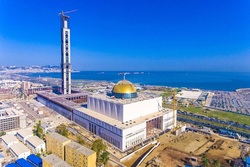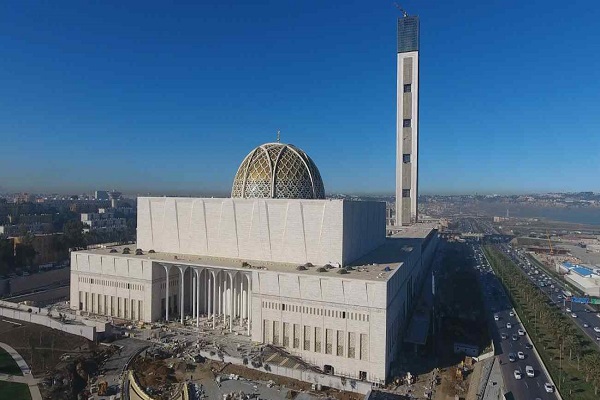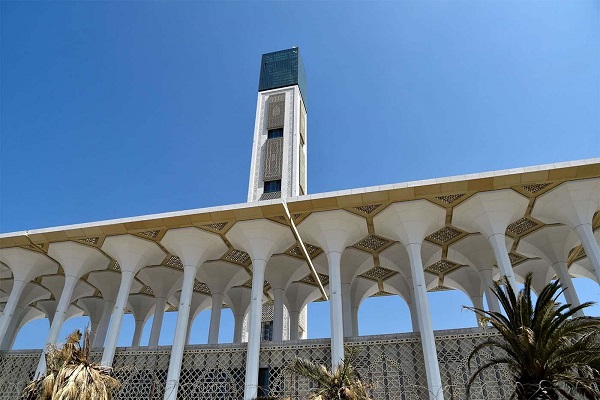Great Mosque of Algiers, Africa’s Largest Mosque


Africa's biggest country, however, is home to a plethora of jaw-dropping and hidden gems that showcase its long and rich history.
Aside from its most prominent attractions in the Sahara desert, Algeria has several fascinating UNESCO World Heritage Sites tracing its tremendous Carthaginian, Roman and Islamic heritage.
Its breathtaking, unspoilt Middleterranean beaches and mesmerizing gardens and national parks are complemented by a wealth of architectural wonders echoing Berber, Arab, Ottoman, and colonial Spanish and French influences that relate Algeria's rich past.
The capital city is home to Notre Dame d'Afrique, a counter-piece to the iconic Notre-Dame de la Garde basilica in France. At the foot of the city's UNESCO-listed Casbah also lies the Ketchaoua Mosque, built in the 17th century during Ottoman rule before it was converted into a Cathedral during French rule and then destroyed, rebuilt as a church and converted back to a mosque.
But Algiers is also home to Africa's most expensive structure.
Billed as Africa's biggest mosque, the Great Mosque of Algiers is less than two years old and took nearly seven years to complete. Before its completion in April 2019, the title of Africa's largest mosque belonged to the Hassan II Mosque in Casablanca, Morocco.
The decision to build Africa's biggest mosque may arguably be attributed to the deep-rooted rivalry between Algeria and Morocco, which dates back to at least the Sand War of 1963 and exacerbated over the years with political differences and the two countries standing on opposing sides of the ongoing conflict in Western Sahara.
Critics see the mosque as a vanity project, having cost over $1 billion in public money which could have otherwise been invested in creating employment and sustainable growth. The mosque is also viewed as a symbol of the reign of Algeria's long-time President Abdelaziz Bouteflika.
But the man behind the project was not around to see it come to fruition. Bouteflika was forced out of power in the same month the mosque's construction was completed, after mass protests broke out across the country against his two-decades-long autocratic rule.
Ironically, while Beijing has been under fire in recent years over its gross mistreatment of its minority Muslim Uyghur population, the mosque was built by the state-backed China State Construction Engineering. The construction company brought in laborers from China to work on the monumental project which constitutes the world's third largest mosque after Islam's two holiest sites, the Great Mosque of Mecca and Al-Masjid Al-Nabawi in Medina.
Featuring geometric architecture and a glamorous rectangular courtyard, the mosque was designed by German architects. At 265 meters high, it boasts Africa's tallest minaret, relegating the 210-meter minaret of Morocco's Hassan II Mosque to second place. The tower, which is used for the call to prayer, is fitted with elevators and an observation deck overlooking the capital and the Bay of Algiers.
The mosque's interior boasts Andalusian architecture, decorated in wood, marble and alabaster and adorned with six kilometers of Qur'anic calligraphy and exquisite turquoise prayer mats. The mihrab's simple, toned-down design features only two small columns on either side.



Topped with an illuminated dome that is 50 meters in diameter, the main prayer hall can hold some 37,000 worshippers. The overall compound, though, can house up to 120,000 worshippers with parking spaces on site enough for 7,000 cars.
The mosque's complex includes a Quran school, a library that can host a million books, a museum of Islamic art, and a research center dedicated to the history of Algeria.
The structure, designed to withstand an earthquake of magnitude 9.0, is supported by hundreds of pillars and semicircular arches throughout.
The mosque's first public prayers were not held until the eve of the birthday of the Prophet Mohammed (PBUH) in October 2020, with a small number of attendees amid the coronavirus pandemic restrictions.
For a country which has no shortage of mosques, both historic and new, the decision to embark on such a costly and ambitious structure has rightly been called into question. However, one can only hope that the mosque will indeed be the theological, cultural and research center it was intended to be and that it will attract more visitors wishing to discover this magnificent country.
Source: Middle East Monitor



